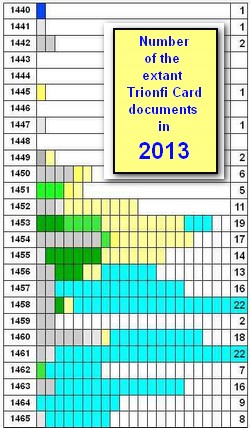Andrea Banchi, 1456
composed by Lothar Teikemeier, last update 06.12.2012
|
Sources
Sources are mainly taken from Franco Pratesi's new article series written from November 2011 till now, published here at Trionfi.com.| SOURCE 1: Silk dealer aquire decks |
|
Quote from Franco Pratesi: "1456 – CURIOUS SHIPMENTS BY ANDREA BANCHI", 03.03.2012 |
2. Andrea Banchi’s life«Andrea di Francesco di Banco was born September 20, 1372, and lived to be a nonagenarian, dying on October 12, 1462. Nothing is known about his early years. His father and his uncle Lodovico both died of the plague in 1390. Andrea probably worked from 1390 onward for his only surviving uncle, Michele.» «From 1421 until 1428 Andrea Banchi carried on without a partner. In the shop in Via Por S. Maria he sold silks at retail. Soon he began producing silk fabrics as well.» «In 1428 Banchi decided to expand his business activities. As an independent merchant-entrepreneur, he continued the production and sale of silk cloth. In addition, he formed a partnership with Piero d’Andrea Petrini to carry on a retail shop dealing in silk goods.» 3. Banchi’s production and commerce«Some silks were sold by Banchi to merchants engaged in the import-export business, and the extant records for 1454 and later years show that about a third of the firm’s output was bought by such merchants, partly in exchange for raw silk. Banchi also tried to sell his products abroad by sending them on consignment to commission agents.» |
|
Repeated Note: When Ross Caldwell and me in 2003 started to collect Trionfi notes between 1442-1463, we had about 27/28 entries (which I nowadays would count as 31). The major part were the documents of Ferrara, which were collected by Gherardo Ortalli and Adriano Franceschini in the "Prince and the Playing Cards" (1996), after the base laying works of Michael Dummett and Stuart Kaplan around 1980. This collection included 2 notes about Trionfi cards in Florence, found by Franco Pratesi in his earlier work (allowances of the Trionfi game in 1450 and 1463). A graphical representation of this time (with 27 entries) shows the dominance of Ferrarese documents (in black) with a few notes only from other locations (in red; see picture to the right) In the period 2004 till October 2011 it was possible to add 4 further notes (Siena 1452, Padova 1455, Ancona c. 1460 and Valerio Marcello c. 1460), mainly thanks to information given by Thierry Depaulis. Franco Pratesi started his new article series in November 2011. Since then the list has gotten 67 new documents till September 2012 (65 of them found by Franco Pratesi, one, now the oldest of September 1440, by Thierry Depaulis, and another one by Veber Gulinelli, who controlled the earlier work of Franceschini and found an overlooked document) and nearly all are related to Florence or its surrounding. A small book (118 pages) was published around Christmas 2012, Franco Pratesi: "Playing Card Trade in 15th Century Florence" as IPCS Paper No. 7 (ISSN 0305-2133). It contains some of the articles, which before had appeared at this website, those, which treat the early time of 15th century. Thierry Depaulis commented in his foreword: "This book is a landmark in the history of early playing cards in Italy". Well, maybe not the book, but the research is clearly a landmark in various interests. For the collection of early Trionfi notes it somehow means, that we have within the year 2012 about 200 % more data for the period 1440-1462 than mankind had collected in the 200 years before. Added later: In August 2013 the new report of Arnold und Doris Esch: "Aus der Frühgeschichte der Spielkarte. Der Import von carte da giocare und trionfi nach Rom." in Gutenberg Jahrbuch 2013, 88. Jahrgang, p. 41-53, arrived in our redaction. It contains 106 new references to Trionfi decks, which all were found in the customs registers of the city Rome for the period 1453-1465. With this the number of all earlier Trionfi cards records has been doubled and should have reached then c. 210 (from which a few are only considered to be "Trionfi card notes" and don't contain the word "Trionfi" or something similar). *********** I'd started to sort the new Trionfi card documents overview in October 2012. Articles will be possibly changed according improvements in research. |
|


